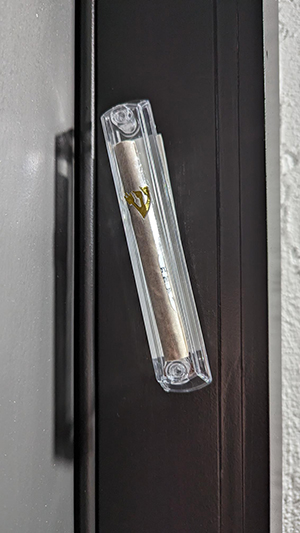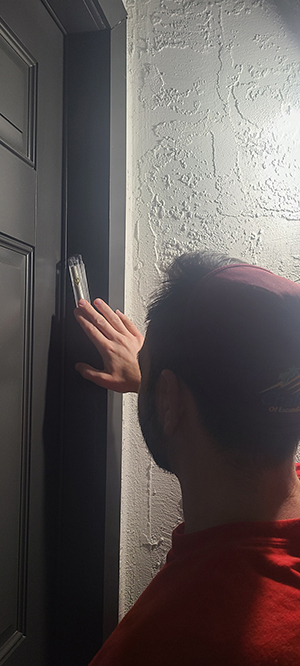By Miriam Gershenson


ESCONDIDO, California — It was almost 8:30pm when the doorbell rang. We have been waiting for this very moment since moving to our new home two months ago. River, our dog, was barking with excitement. I had to take her to the dining room and close the gate while my husband, Albert, opened the door. Rabbi Meir Friedman of Chabad of Escondido walked in holding the mezuzah. After a bit of small talk, he told us the significance of the mezuzah and the process of putting it up.
Albert stuck the mezuzah to the door frame and said the prayer. Just like that, the process was done. Is this what we waited for? As a matter of fact, yes. While the physical aspect was so quick, it is the spiritual side that was filled and is overflowing. The mezuzah, a small but significant symbol in Jewish tradition, holds deep meaning and centuries-old history. Affixed to door frames in Jewish homes, the mezuzah serves as a constant reminder of faith, identity, and the connection to the Divine.

What Rabbi Friedman explained to us was that the mezuzah is one of the “Hallmark” commandments. Meaning, we place it mostly to publicly announce we are proud Jews. It also helps us to keep God at the forefront of our minds and feel that God is standing at the door guarding us. Lastly, and what I felt was most important, it is a reminder that Judaism isn’t just going to a temple, it is a way of life. My favorite part from everything the Rabbi said was his metaphor that went something along the lines of, “If God was to walk in right now, would you be happy how he finds you?” All this to say, you should be the same at home as you are at the temple.
During our conversation, the Rabbi pointed out some fun facts for us such as a belief some have that having a mezuzah leads to a long life. We also learned that the reason the mezuzah is at an angle is because the decision makers couldn’t decide if the mezuzah should be upright or horizontal so they compromised on it being slanted towards the entry. It was also decided that the mezuzah needs to be placed on the lower part of the top third of the door frame.
A Mezuzah can come in many colors, designs, and materials. Ours is in a clear plastic so the parchment inside could be seen. There is one decorative aspect to it which is the Hebrew letter, Shin. Shin is the first letter of the Hebrew word “Shaddai” which translates to “Almighty” in English. Upon some research, I found out that some believe that the Shin on the Mezuzah is there to represent Shabbat which starts with the letter Shin.
The parchment inside this little vessel is called “klaf.” I learned while writing this very article that the klaf must be kosher to be valid and that means that the klaf must be made out of the skin of a kosher animal. Frankly, I wish I never learned it- ignorance was bliss in this case. With a quill from a kosher bird, Shema is handwritten within the klaf. The reason Shema is the one written inside is because it is believed to be the most important of prayers in Judaism because it reminds us that there is only one God.
With Passover coming, we concluded the conversation by making a connection. Israelites placed the blood of a sacrificed lamb on their door frames to signal to God to pass over their homes when coming to kill the firstborn of the Egyptians. A symbol on the door frame then protected us, and a symbol on the door frame protects us today. Whether as a simple wooden case or an ornate work of art, the mezuzah carries with it the weight of history, the richness of tradition, and the promise of divine protection for those who dwell within.
*
Gershenson is a dog-loving, Israel-born, HR professional currently residing in Escondido.